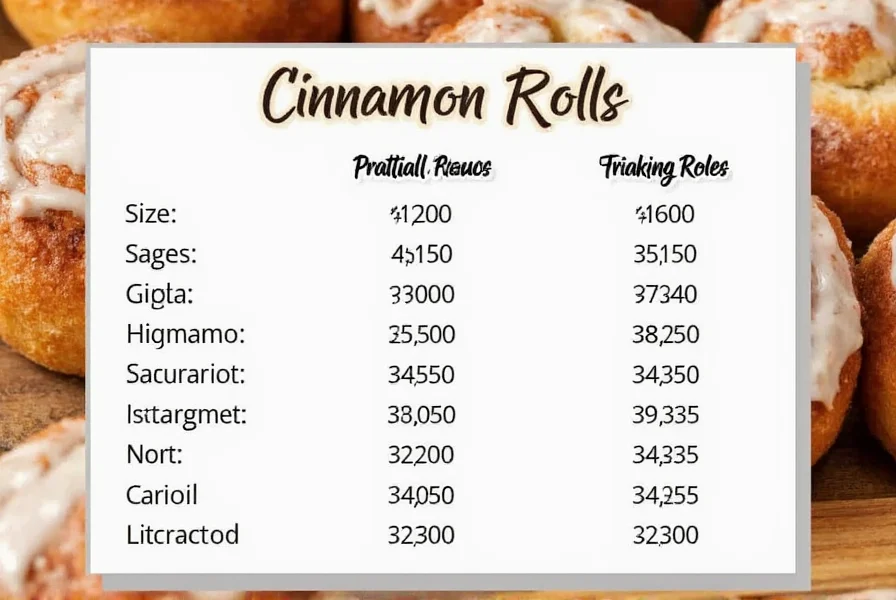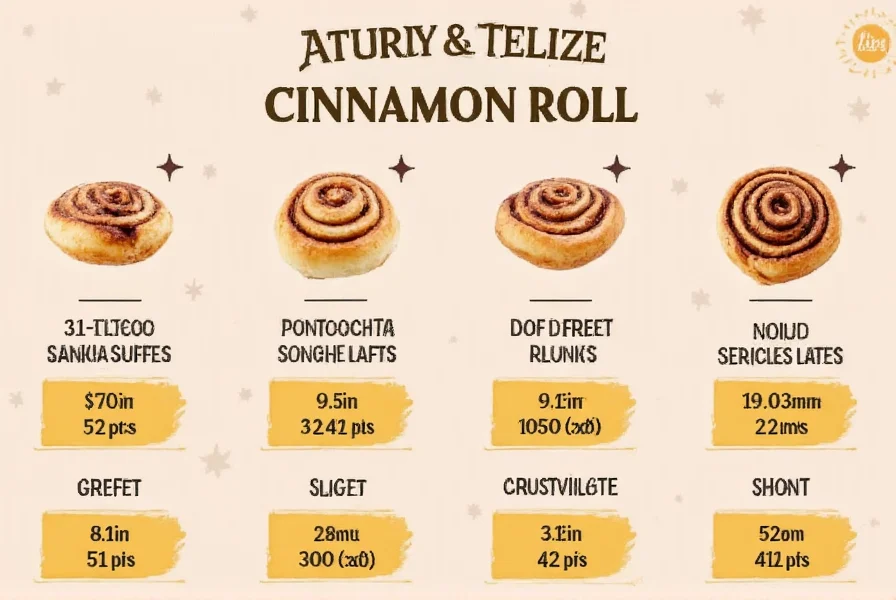A standard homemade cinnamon roll (approximately 2.5 ounces or 70 grams) contains between 180-220 calories. Large bakery-style cinnamon rolls can range from 300 to 880 calories depending on size and ingredients. The calorie count varies significantly based on preparation method, portion size, and additional toppings like icing.
Understanding cinnamon roll calories is essential for anyone tracking their nutritional intake. Whether you're enjoying a homemade treat or purchasing from a popular bakery chain, knowing the exact calorie content helps make informed dietary choices. This comprehensive guide breaks down calorie counts across different preparation styles and portion sizes, providing valuable context for incorporating this beloved pastry into your eating plan.
Calorie Breakdown by Cinnamon Roll Type
Cinnamon rolls aren't one-size-fits-all when it comes to calorie content. The preparation method, ingredients, and portion size dramatically impact the final nutritional profile. Let's examine the calorie differences across common varieties.
| Type of Cinnamon Roll | Approximate Weight | Calorie Range | Key Contributing Factors |
|---|---|---|---|
| Homemade (standard) | 70g (2.5 oz) | 180-220 | Butter content, sugar amount, icing |
| Bakery chain (medium) | 100-120g (3.5-4.2 oz) | 300-450 | Extra butter, larger size, thick icing |
| Bakery chain (large) | 170-200g (6-7 oz) | 500-880 | Multiple layers, heavy icing, fillings |
| Store-bought frozen | 55-75g (2-2.6 oz) | 170-250 | Preservatives, portion control |
| "Skinny" or reduced-calorie | 60-70g (2.1-2.5 oz) | 120-160 | Substitute ingredients, less icing |
Factors That Impact Cinnamon Roll Calories
Several elements determine the final calorie count of your cinnamon roll. Understanding these factors helps explain why calorie counts vary so dramatically between different sources.
Dough Composition
The base dough significantly affects calorie content. Traditional yeast-raised dough contains flour, butter, milk, sugar, and eggs. The amount of butter incorporated into the dough (both in the base and as a layer before rolling) substantially increases calories. Some recipes use oil instead of butter, which can slightly reduce calories but often affects texture and flavor.
Filling Ingredients
The cinnamon-sugar filling seems simple but contributes more calories than many realize. A standard filling uses 1/4 to 1/2 cup of sugar per batch of rolls. Some recipes add melted butter to the filling, creating a richer but higher-calorie product. Alternative sweeteners like coconut sugar or maple syrup don't significantly reduce calories but may offer different nutritional profiles.
Icing or Frosting
The icing often contains more calories than the roll itself. Cream cheese icing, while delicious, adds substantial fat and sugar. A single tablespoon of cream cheese icing contains approximately 50-70 calories. Many bakery-style rolls feature generous amounts of icing, sometimes doubling the total calorie count compared to an un-iced roll.
Nutritional Context: Where Cinnamon Roll Calories Fit
Understanding how cinnamon roll calories fit within daily nutritional needs provides valuable perspective. For adults following a standard 2,000-calorie diet:
- A standard homemade roll represents 9-11% of daily calories
- A medium bakery roll accounts for 15-22% of daily calories
- A large bakery roll can be 25-44% of daily calories
Carbohydrates typically make up 60-70% of a cinnamon roll's calories, with fats contributing 25-35%, and protein making up the remaining 5-10%. The sugar content ranges from 15-40 grams depending on size and preparation.
Homemade vs. Store-Bought Calorie Comparison
When considering cinnamon roll calories homemade versus store-bought options, several patterns emerge:
Homemade cinnamon rolls generally allow for more control over ingredients and portion sizes. You can adjust butter content, sugar amounts, and icing thickness to manage calorie counts. Many home bakers find they can create satisfying rolls with 25-30% fewer calories than commercial versions by making strategic ingredient substitutions.
Store-bought frozen cinnamon rolls often contain preservatives and stabilizers but may have slightly lower calorie counts due to standardized portioning. Popular bakery chains typically create larger, richer rolls with higher calorie density. For example, a well-known coffee chain's standard cinnamon roll contains approximately 330 calories, while their seasonal specialty can exceed 500 calories.

Making Informed Choices About Cinnamon Roll Calories
Enjoying cinnamon rolls while managing calorie intake doesn't require complete elimination. Consider these practical approaches:
- Share larger bakery rolls with a friend to halve the calorie impact
- Choose rolls without additional fillings like nuts or chocolate
- Request less icing or skip it entirely for significant calorie savings
- Opt for smaller portion sizes when available
- Balance your cinnamon roll with lower-calorie meals throughout the day
Remember that occasional indulgence fits within a balanced eating pattern. The key is understanding what you're consuming and making conscious choices that align with your overall dietary goals. Tracking cinnamon roll calories for weight management becomes much easier when you know the typical ranges for different preparation styles.
Frequently Asked Questions
How many calories in a Cinnabon classic roll?
A standard Cinnabon Classic Cinnamon Roll (approximately 5.2 ounces or 147g) contains about 880 calories. This includes the rich cream cheese frosting that contributes significantly to the total calorie count. Their mini rolls contain approximately 310 calories each.
Are there lower calorie cinnamon roll options available?
Yes, several lower calorie cinnamon roll options exist. Some bakeries offer "mini" versions ranging from 150-250 calories. You can also find reduced-calorie frozen options at grocery stores (typically 120-180 calories). Making homemade cinnamon rolls allows the most control—you can reduce butter content, use sugar substitutes, and minimize icing to create versions with 120-160 calories per roll.
How does icing affect cinnamon roll calories?
Icing significantly increases cinnamon roll calories. A standard un-iced roll might contain 150-180 calories, while adding a typical cream cheese icing can add 50-120 calories depending on the amount used. Bakery-style rolls often feature generous icing that can double the calorie count compared to the base roll. Skipping the icing or requesting it on the side can substantially reduce the total calories.
What's the calorie difference between homemade and store-bought cinnamon rolls?
Homemade cinnamon rolls typically contain fewer calories than store-bought versions when prepared with standard recipes. A homemade roll averages 180-220 calories, while a comparable store-bought frozen roll ranges from 170-250 calories. However, popular bakery chain rolls are substantially higher, often containing 300-880 calories. The difference comes from portion sizes, ingredient quality, and the amount of butter and sugar used in commercial preparations.
How many calories in a large cinnamon roll from a coffee shop?
Large cinnamon rolls from popular coffee shop chains typically contain 300-500 calories. For example, a standard cinnamon roll from a major coffee chain contains approximately 330 calories, while their seasonal specialty rolls can exceed 500 calories. These counts include the substantial amount of icing that's characteristic of coffee shop pastries. Always check current nutritional information as recipes and portion sizes may change.











 浙公网安备
33010002000092号
浙公网安备
33010002000092号 浙B2-20120091-4
浙B2-20120091-4